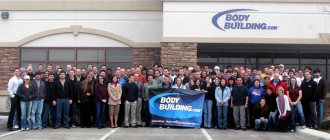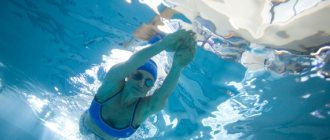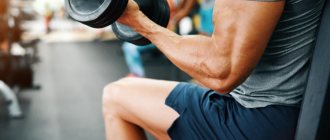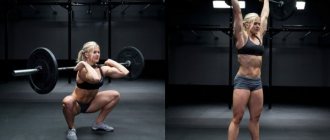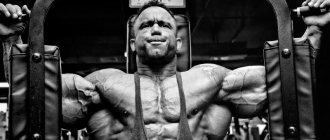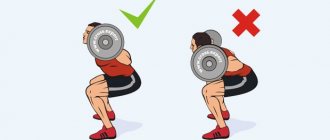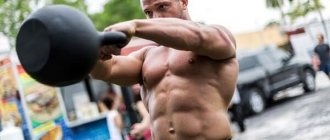Drying the body for a man is a period when an athlete trains in order to give his muscles definition. Some athletes “dry” easily, while others experience some difficulties in this matter. The first include ectomorphs (thin athletes, with a small proportion of muscle tissue) and mesomorphs (muscular men, with a small percentage of fat); others are typical endomorphs (athletes with a large percentage of body fat).
A thin man (ectomorph) has great difficulty developing muscles, but his “relief” cycle goes through easily, without complications or difficulties. He practically does not need aerobics - insofar as his muscles are naturally of high quality. Training in a “pumping” mode (many sets of high repetitions with relatively light weights) and diet will do their job without any drugs or aerobic training.
A mesomorph gains muscle mass relatively quickly and easily. During the drying period, he also does not experience any particular difficulties. The exceptions are those young people who eat poorly, do a lot of aerobic exercise, and “diet” more than they should. The acquisition of relief in such athletes is accompanied by a loss of muscle mass.
The endomorph does not gain weight very quickly, although he does not experience great difficulties in developing strength, and it is even more difficult for him to achieve muscle definition. He needs aerobic training. He also needs to strictly “sit” on a diet. The slightest deviation will significantly slow down the process of body restoration.
Basics of drying the body for men - nutrition and training
It happens that both genetically gifted men and hard gainers (young people for whom physical development is difficult) experience great difficulty when training to give their muscles relief. This happens when the program for drying the body is designed incorrectly, or the athlete makes mistakes in training. Also, the reason for the failure may lie in his diet. Nutrition for drying the body should not be the same as during the “strength” and “mass” periods, but a “shortage” of the daily dose will certainly have a negative impact - either on the athlete’s condition during training, or on his body.
By eating incorrectly, an athlete, along with gaining relief, loses muscle tissue. At the same time, the health and functioning of internal organs deteriorates. The consequences may be irreversible. For example, when an athlete sits on a protein diet for too long, consuming protein much more than his norm, his kidneys and liver begin to malfunction, as a result of which he has to resort to a diet for liver disease. Ailments of this kind are often “attributed” to the use of steroids, which in fact in such cases are only partly to blame, or not at all. If you take the “chemistry” a little and systematically, it will not cause any harm.
Body drying for men - menu
The body drying diet for men differs from other diets in that it is slightly different on different days. That is, on the day of training the athlete should consume a little carbohydrates , and on the “off” day completely ignore them . Of course, it is not possible to completely avoid the consumption of carbohydrates - since they are present in greens, vegetables, and fruits. But it is possible to give up food where carbohydrates predominate. You also need to take into account that on the day of training you need to consume carbohydrates with a low glycemic index (porridge, vegetables). Sweets (carbohydrates with a high glycemic index) will not harm the athlete’s body, but will slow down the drying process.
Any athlete, regardless of somatotype (body type - mesomorph, ectomorph, endomorph), should consume 1/3 more protein than he consumes during the period of strength development. That is, if an athlete needs 1.5 - 2 g of protein per 1 kg of body weight per day to maintain performance and build muscles, then during the drying period he should consume approximately 2.5 g of protein per 1 kg of body weight.
Rules for drying the body
- Having breakfast is a must! Skipping your morning meal slows down your metabolism.
- You need to eat frequently: 5 times a day, every 2-3 hours. Often, eating in fractional portions prevents the body from becoming “starved” and storing fats in reserve.
- The last meal is 2 hours before bedtime.
- 2/3 of the daily ration should be eaten in the first half of the day.
- Completely eliminate alcohol, sweets, fast food and sauces from your diet.
- Don't forget about water - you need to drink at least 2 liters of water a day!
- Take vitamins and multivitamin complexes , as a lack of certain vitamins can negatively affect muscles.
- The diet should contain healthy fats , which are found in fish or nuts.
How to calculate the calorie content of food?
Depending on height and body weight, it is necessary to calculate the calorie content of food. There are a huge number of sites on the Internet that specialize in proper nutrition and calculating the calorie content of food. There you can enter your data: gender, age, height, weight, indicate your goal (weight gain or loss), other parameters and get the required calorie intake.
There are also excellent mobile apps that calculate the calorie content of each meal, protein, fat and carbohydrate content. In such applications, you can specify the time of food intake, track the dynamics of calories, body volume, weight, etc.
Depending on the desired speed of achieving results, body weight, metabolism, and individual characteristics of the body, the caloric content of food intake should be 2-3 thousand kcal. Having decided on the required calorie content, you need to calculate the need for proteins, proteins and carbohydrates. You need as little fat as possible (up to 50 g per day), more proteins and carbohydrates (150-200 g). To monitor your results, you need to weigh yourself every week. This way you can track the dynamics of changes in body weight and make adjustments to your training program and nutrition.
BZHU during the drying period
On the day of training, carbohydrates should be present in the athlete's diet . But these, as already mentioned, must be complex carbohydrates. Complex (also called complex) carbohydrates are black bread, cereals, pasta and fruits and vegetables. Sweets (i.e., simple carbohydrates) can be consumed by ectomorphic athletes, but in small quantities, and in no case should they be consumed before training. After training, eating sweet foods is acceptable - insofar as during this period the body needs glucose. The second meal after training should consist of complex carbohydrates with a small amount of protein.
Let's calculate the required amount of carbohydrates, proteins and fats. For example, let's assume that your body weight is 85 kg.
Proteins - 2 g per 1 kg of body weight (85 x 2 = 170 g). It is advisable to consume proteins throughout the day in equal portions of about 30 g, but if there is more in some portion, it’s okay: proteins take quite a long time to digest.
Carbohydrates - from 2 to 7 g per 1 kg of body weight for normal nutrition, when cutting we reduce it to a minimum - 2 g (85 x 2 = 170 g)
Fats - they are definitely needed, the golden rule is 0.5 g per 1 kg of body (85 x 0.5 = 42.5 g of fat per day)
Calories are secondary. The number of calories (of course, we are talking about kilocalories, Kcal) is calculated based on the amount of proteins, carbohydrates, fats:
Carbohydrates – 4 Kcal/g
Proteins – 4 Kcal/g
Fats – 9 Kcal/g
Example: for our diet, the number of calories (we take carbohydrates to the maximum) is as follows: 170*4+170*4+42.5*9 = 1742.5 Kcal
Menu for the day when drying
Below is an approximate basic menu for a man 80-85 kg:
8.00 - Chicken - 100 g (turkey, beef, veal), porridge - 100 g (buckwheat, rice, pasta, oatmeal, barley)
10.00 - Cottage cheese 0-4% - 400 g
12.00 – Apples 300 g
14.00 - same as 8.00
16.00 - Cottage cheese 400 g
18.00 - Chicken 150 g, vegetables - 300 g
20.00 - White omelette 300 g (whites only, discard yolks)
22.00 - Cottage cheese (or protein)
Rice - approximately 200 g complex carbohydrates per 250 g rice
Buckwheat - approximately 200 g of complex carbohydrates per 300 g of buckwheat
In any case, on a day free from training, the athlete’s should consist half of carbohydrate foods , with a small dose (no more than 1/3) of simple carbohydrates .
Food consumed before training (1.5 - 2 hours before it) should consist of natural proteins (cottage cheese, meat, eggs) and complex carbohydrates. What more is an individual matter. It is better for an endomorph to prefer food with a predominance of protein, and for his slender colleagues - with a predominance of carbohydrates.
Diet during drying
When the level of glycogen in the blood decreases, the person’s energy level also decreases, which requires some compensation, otherwise the man simply will not be able to perform exercises during training. To replenish energy reserves, it is recommended to reduce the interval between meals.
Please note: The carbohydrate intake rate is calculated individually, based on the number of kilograms required to achieve clear contours of muscle mass relief.
It is important not to stop taking carbohydrates, which should make up at least 40% of the total daily calorie intake of the prescribed diet. Unsweetened fruits and vegetables, cereals and nuts will help you dry properly. The amount of protein consumed should be at least 2-3 grams per kilogram of the athlete’s own weight; protein should come from low-fat foods. For best muscle preservation, it is recommended to consume proteins.
Video
A balanced diet during drying should include such dishes as:
- boiled, steamed or stewed turkey or chicken meat without skin;
- chicken proteins;
- boiled squid fillet;
- low-fat stewed fish;
- low-fat cottage cheese and kefir, which are recommended to be consumed in the first 2 weeks of drying;
- buckwheat and oatmeal on water;
- pasta made from rye flour;
- grapefruit, green apples, lettuce, broccoli, greens, and zucchini;
- chamomile, ginger and other types of green teas, which are recommended for drying in the summer.
You can successfully dry out muscles only by maintaining proper nutrition and controlling your daily caloric intake, and not by training. You can control your daily caloric intake only by keeping a clear record of everything you eat and constantly weighing yourself. Regular monitoring and following all recommendations will allow you to dry out without harm to your health and gain beautiful muscle definition.
Body drying program for men
Of course, to achieve good results, you need not only to eat right, but also to train properly . Strength training (low reps, high sets, with appropriate weights) coupled with aerobic training may produce some results for a genetically gifted man, but for a hardgainer it will be useless. For an endomorph, such training will not only be useless, it will “help” him store an even greater percentage of fat.
The ideal version of “restoration” training is a program that includes exercises for the whole body, in a high number of repetitions and sets; Among athletes, such training is called pumping . You take a barbell that weighs half as much as the one you can perform 5 reps with, and do 6-10 sets with it until failure, resting no more than 2 minutes between them. In this mode you must execute the entire program. Rest between exercises is the same as between sets - no more than 2 minutes.
When starting a relief program, you need to clearly define the exercises. All the exercises that you are going to do in the gym should ideally match your leverage (a feature of the structure of the joints), that is, be as beneficial as possible for you from a biomechanical point of view. When training to develop strength, the main thing is to use the ligaments and tendons, and when training to develop mass and relief, the muscles themselves. If your triceps don’t “burn” after exhausting close-grip bench presses, then they will be useless (in the case of genetically gifted athletes, of little use) for “pumping” training.
You can modify the program a little. For example, perform supersets in pumping mode. A superset is two sets of different exercises, the second of which is for the antagonist muscle; for example, an arm superset would consist of a French press and a barbell curl. In such cases, both exercises are performed without rest. After the superset - rest for 1.5 - 2 minutes. It is not recommended to perform more than 3 supersets per body part per workout. A larger amount may not harm, but it will not speed up the result.
Exercises for the calves, long back muscles (lumbar muscles), forearms, trapezius muscles and shoulders should be performed as usual. Moreover, all three heads of the shoulders - rear, lateral and front - must work separately. For calves, it is also advisable to perform 2 exercises - standing calf raises and sitting calf raises; The first exercise is for the gastrocnemius muscle, and the second is for the soleus. For the forearms, it is also advisable to perform 2 exercises: one for flexion of the arms, the second for extension.
How to dry properly for muscle definition for men
Alcohol and protein shakes are incompatible concepts, so it is important for representatives of the stronger sex to initially set priorities and choose a goal for themselves. Other bad habits are also excluded, you will have to lead a healthy and active lifestyle, regularly visit the gym. There are a number of valuable techniques on how to properly dry for muscle relief for men, but this issue requires an integrated approach, which includes the following components:
- effective, almost extreme body workout;
- replacing your favorite foods with a strict diet against excess fat.
Do you want to lose weight? Then these articles are for you
Zucchini pancakes recipe is simple and tasty dietary
14 Sauces for the PP diet
PP pancakes for Maslenitsa
The morning of a professional or novice athlete should begin with a protein shake, which, in addition to drying, provides a boost of energy. Training should alternate with periods of recovery, with the emphasis preferably on strength training for guys. By combining muscle work and rest in addition to low-calorie nutrition, a positive result is noticeable in the shortest possible time.
Weekly program for drying the male body
| Day of the week | Exercises for drying the body |
| Monday and Friday | Hack squats superset with deadlifts. Dumbbell bench press in a superset with a vertical block row. Barbell curls in a superset with a similar exercise, but with an underhand grip. Donkey exercise (calf training). Seated calf raise (exercise for soleus muscles). |
| Wednesday | Hyperextension. Raises of arms with dumbbells, standing straight (training the lateral heads of the deltas). Raising your arm in front of you (training the front deltoids). Arm raises while standing bent over (exercise for the rear deltas). Lifting the barbell for biceps in a superset with arm extensions. |
Squats and deadlifts will keep your abs in shape. In other cases, abdominal training is necessary. On Monday and Friday, abdominal training should be gentle; 5 sets of classic crunches will be enough. Nothing more serious will happen - insofar as the abdominal muscles are already noticeably tired in squats and deadlifts.

